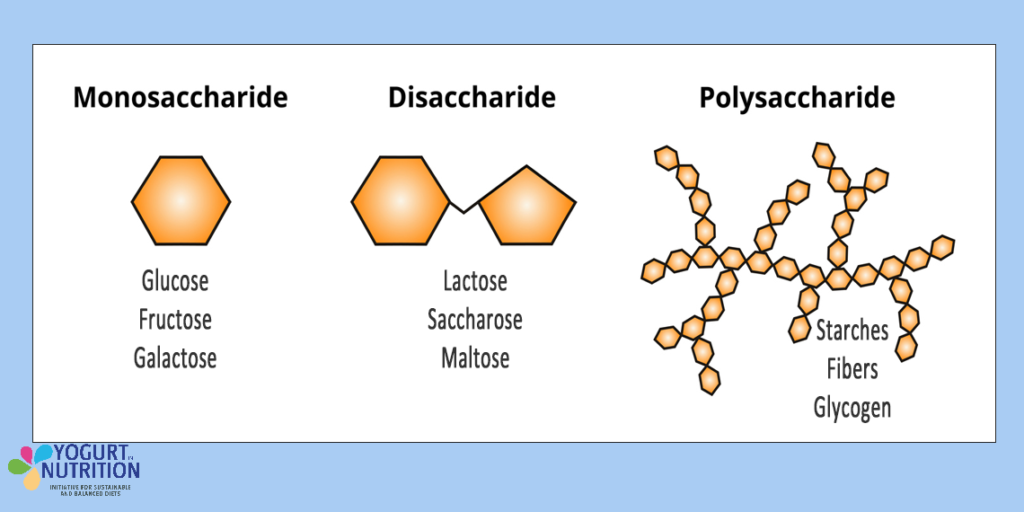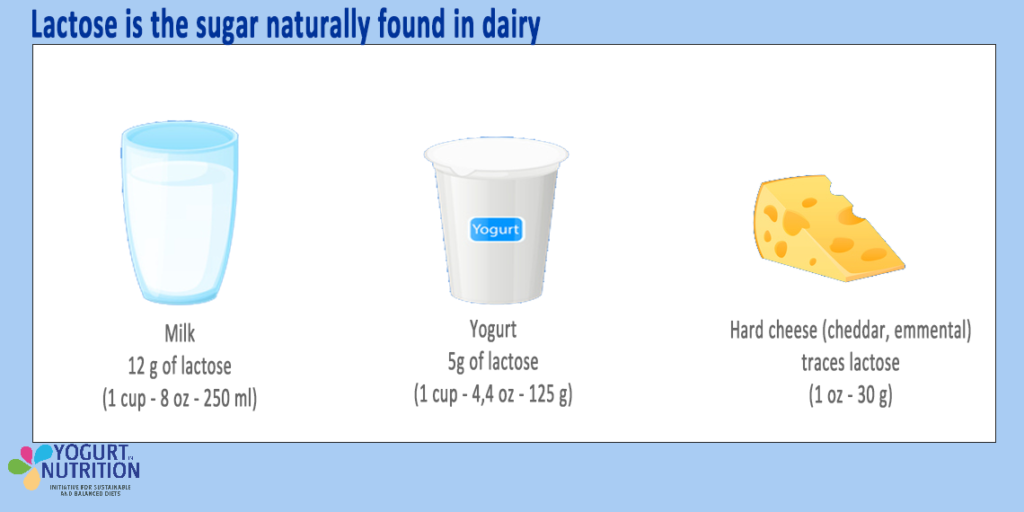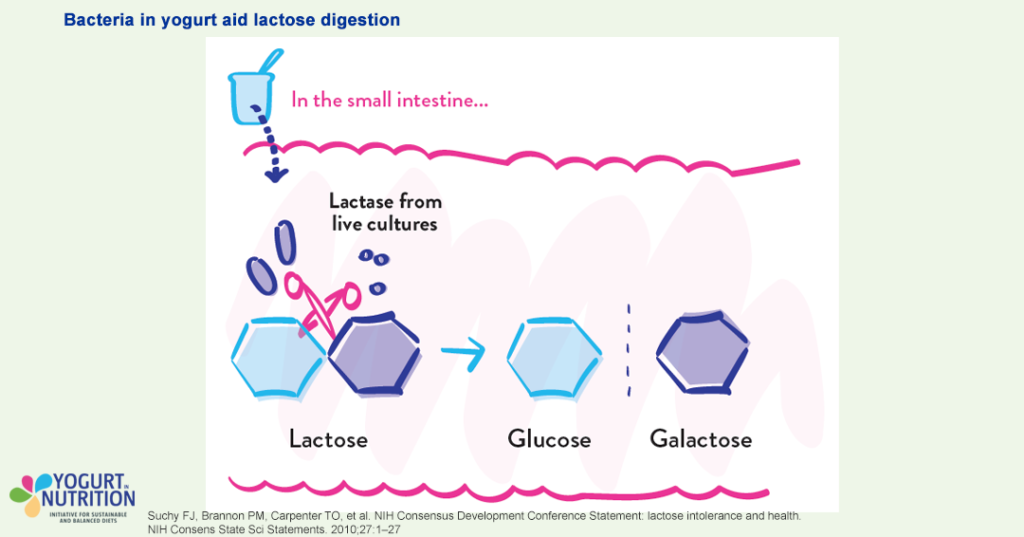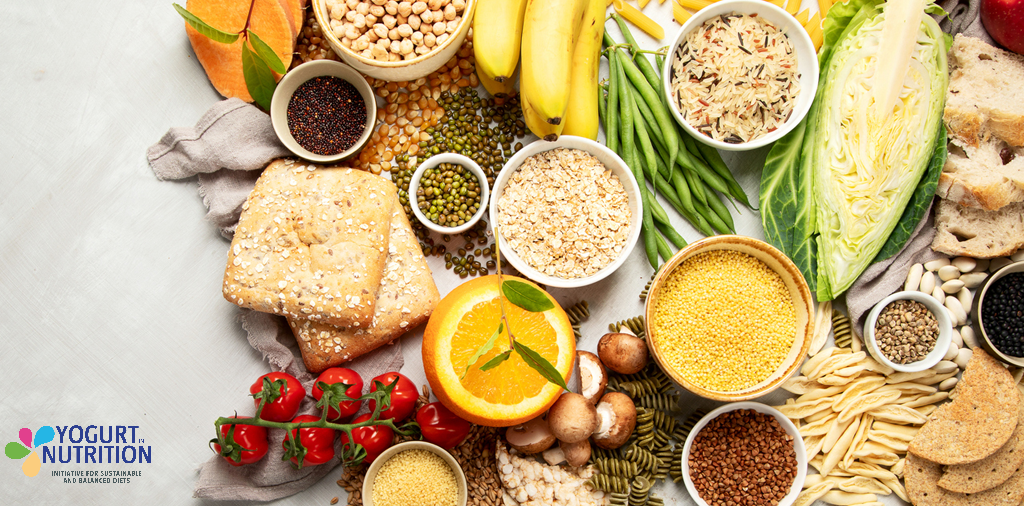Carbohydrates are an essential part of our diet. They are present in a majority of foods and they provide the body with energy to sustain metabolic functions. Let’s focus on carbohydrates and especially the main one present in yogurt: lactose.
What are carbohydrates?
Carbohydrates are chains of sugar compounds linked together by chemical bonds. These chains can be as little as 2 sugars to over 20 sugars longs. Depending on how long the chains are and which sugars compose them, they will have different properties and effects in the body. Carbohydrates can be divided into 2 main categories: simple and complex.

Simple carbohydrates are what we refer to as sugars.
They can be further divided into 2 categories: monosaccharides and disaccharides. Monosaccharides are the single sugar units that compose all carbohydrates, these are for example glucose, fructose and galactose. Disaccharides are carbohydrates which are made up of 2 sugars such as sucrose or lactose. Sucrose is what we know as table sugar and has a sweet taste.
All carbohydrates are broken down into the single units of sugar by specific enzymes that break the bonds between sugars. The monosaccharides are then absorbed into the body by the small intestine. Since there is one or no bonds in simple sugars, they are digested and absorbed quickly by the body and they will cause rapid changes in blood sugar. Simple sugars can be found naturally for example in fruits and vegetables or in milk. Or they can be added into food, for instance, table sugar is added to baked goods or sodas.
Complex carbohydrates are also called polysaccharides.
They are chains longer than 10 monosaccharides. Some examples of polysaccharides are starch, glycogen or fibre.
These are called complex carbohydrates because the body can’t digest carbohydrates in their chain form, it has to break them down to absorb the individual monosaccharides units. This process takes longer than for simple sugars causing a more stable gradual change in blood sugar.
In the case of fibre, the body can’t break the structure down as it does not possess the enzyme to do so and it will pass through the small intestine without being absorbed and get fermented in the colon by the gut bacteria. This fermentation produces short chain fatty acids which help nourish the bacteria and protect the gut.
Dietary recommendations for carbohydrates
It is recommended that 45-60% of total daily energy intake in the diet come from carbohydrates and to consume at least 25g of fibre a day.
It is also recommended to keep the added sugar consumption to less than 10% of the total energy intake of the diet.
Focus on lactose
Lactose is a carbohydrate composed of 2 sugar compounds which are glucose and galactose. Lactose is the main sugar in milk. As it is naturally present in milk, it does not count towards added sugar consumption.
Lactose is a sugar without sweet taste. Its sweetening capacity is 30% of the one of saccharose (whereas fructose is 110% and glucose 70%). And it has a low glycaemic index of 46, compared to glucose (GI=103) or saccharose (GI=65).
Human milk contains 7.2% of lactose, which provides up to 50% of an infant’s energy needs. Compared to only 4.7% of lactose in cow’s milk.
Its individual sugar components have different roles in the body. Glucose is the preferred source of energy of the body and galactose is utilised in core body functions such as, for example, being a part of the antigen that determines the ABO blood types. Although glucose could be found in several types of foods, lactose is the only source of galactose.
During digestion, lactose is broken down by the enzyme lactase which separates the 2 sugars that are then absorbed separately.
The ability to digest lactose naturally decreases after weaning as we produce less lactase. People with lactose intolerance don’t produce enough lactase. Undigested lactose reaches the colon and is broken down by the gut microbiota through fermentation, which produces short chain fatty acids and gas. This can lead to symptoms such as bloating, cramps, diarrhoea and flatulence. Only 1/3 of lactose maldigesters have symptoms and are lactose intolerant.
Yogurt and lactose
The amount of lactose in dairy products varies depending on their type and processing. Cheese has only traces amounts of lactose and yogurt as over half the amount found in milk.

The reduced amount of lactose contained in yogurt can be explained by the specific bacterial cultures present in it (Lactobacillus delbrueckii subsp. bulgaricus and Streptococcus thermophilus). They produce lactase and break down some of the lactose in the yogurt. The bacteria also survive passing through the gut and will help digestion of lactose even further in the small intestine. As yogurt is semi-solid, it has been found to take longer to go through the digestive tract than milk making the breakdown of lactose even more effective. Yogurt is a good source of easily digestible galactose.

In general, it is recommended to consume 2 to 3 portions of dairy products each day. Dairy is nutritionally dense as it provides a multitude of nutrients needed in a healthy diet. Yogurt is an easily digestible source of dairy recommended by EFSA as a dairy product for lactose maldigesters. When choosing yogurt, it is preferred to opt for a plain yogurt over a sweetened one so as to limit the amount of added sugar consumed in the diet.
For more information:
- What is the role of lactose?
- Lactose as a nutrient
- Benefit of yogurt for lactose digestion
- Yogurt is recommanded for people with lactose maldigestion
Sources
- Savaiano DA. Lactose digestion from yogurt: mechanism and relevance. Am J Clin Nutr. 2014 May;99(5 Suppl):1251S-5S.
- Gómez-Gallego C, Gueimonde M, Salminen S. The role of yogurt in food-based dietary guidelines. Nutrition Reviews. 2018;76: 29–39.
- Romero-Velarde E, Delgado-Franco D, García-Gutiérrez M, Gurrola-Díaz C, Larrosa-Haro A, Montijo-Barrios E, Muskiet FAJ, Vargas-Guerrero B, Geurts J. The Importance of Lactose in the Human Diet: Outcomes of a Mexican Consensus Meeting. 2019 Nov 12;11(11):2737.
- Conte F, van Buuringen N, Voermans NC, Lefeber DJ. Galactose in human metabolism, glycosylation and congenital metabolic diseases: Time for a closer look. Biochim Biophys Acta Gen Subj. 2021 Aug;1865(8):129898.
- Food-Based Dietary Guidelines in Europe – table 7 | Knowledge for policy. [cited 17 Jan 2024].
- Cummings JH, Stephen AM. Carbohydrate terminology and classification. Eur J Clin Nutr. 2007 Dec;61 Suppl 1:S5-18.
- Holesh JE, Aslam S, Martin A. Physiology, Carbohydrates. [Updated 2023 May 12]. In: StatPearls [Internet]. Treasure Island (FL): StatPearls
- EFSA Panel on Dietetic Products N, Allergies. Scientific Opinion on the substantiation of health claims related to live yogurt cultures and improved lactose digestion (ID 1143, 2976) pursuant to Article 13(1) of Regulation No 1924/2006.
- Diabetes.org – Understanding carbs
- Valeurs nutritionnelles de référence | EFSA. 22 Dec 2023
- Guerville M, Ligneul A. Lactose: A sugar like no other [Le lactose, un sucre pas comme les autres]. Cahiers Nut et Diét. 2024. doi:10.1016/j.cnd.2023.12.004
- Foster-Powell K, Holt SH, Brand-Miller JC. International table of glycemic index and glycemic load values: 2002. Am J Clin Nutr. 2002 Jul;76(1):5-56. doi: 10.1093/ajcn/76.1.5. PMID: 12081815.
- Davis EA. Functionality of sugars: physicochemical interactions in foods. Am J Clin Nutr. 1995 Jul;62(1 Suppl):170S-177S. doi: 10.1093/ajcn/62.1.170S. PMID: 7598075.



